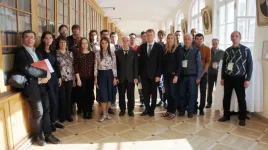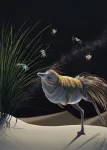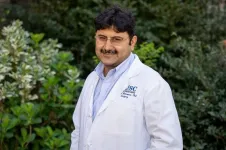(Press-News.org) As the human body's largest organ, the skin is responsible for protecting against a wide range of possible infections on all fleshy surfaces, from head to toe. So how exactly does the skin organize its defenses against such an array of threats?
A new Yale study shows that the epidermis, the outermost layer of skin, is comprised of an army of immune cells that station themselves at regular intervals across the skin's vast expanse to resist infection. When necessary, the researchers found, these immune system soldiers are able to reposition themselves to protect vulnerable areas.
The study, published in the journal Nature Cell Biology, was conducted by the lab of Valentina Greco, the Carolyn Walch Slayman Professor of Genetics, at Yale School of Medicine.
"It's a surveillance system with two separate roles," said Catherine Matte-Martone, manager of the Greco lab manager and co-first author of the study. "The skin controls the sentinels by mediating their numbers based on its own density, while they in turn provide dynamic coverage to prevent cracks in the skin's defenses."
The epidermis contains two main types of immune system cells, Langerhans cells (LCs) and dendritic epidermal T cells (DETCs). In the study, the research team led by Matte-Martone and Sangbum Park, a researcher from Michigan State University (MSU), captured images of these immune system cells interacting with epithelial cells, the closely packed skin cells that comprise most of the epidermis.
They found that the immune system cells are distributed in a distinct pattern, maintaining a minimum distance between the individual cells. According to the researchers, these immune cells seem to have the ability to avoid each other, preventing clusters in any locations and maintaining a consistent distribution.
The phenomenon is similar to a property observed in neurons, in which scientists have observed a tendency of neurons from a single branch to avoid each other.
"Our study suggests that LCs and DETCs appear to have a mechanism of 'self-avoidance,', similar to neuronal cells," said Park, an assistant professor at MSU and former postdoctoral fellow in the Greco lab at Yale.
When the team removed some immune cells in one area, they observed that the remaining cells were able to reposition across the skin tissue to defend the gaps in coverage. They also found that they could disrupt the normal distribution of those cells by knocking out a gene known as Rac1 (Ras-related C3 botulinum toxin substrate 1), which regulates projections on immune cells called dendrites. This process, they hypothesize, helps maintain the distance between immune cells.
The findings illustrate how specialized cell types can cooperate to carry out a larger role within the body.
"It is fascinating to observe how these different cell types co-exist and interact together in a developmental context rather than an immunological one," Martone said.
INFORMATION:
Other Yale authors include Ann Haberman, director of the In Vivo Imaging Facility at Yale, and David Gonzalez, manager of both the Imaging Facility and the Greco Lab.
The introduction of lithium-ion (Li-ion) batteries has revolutionized technology as a whole, leading to major advances in consumer goods across nearly all sectors. Battery-powered devices have become ubiquitous across the world. While the availability of technology is generally a good thing, the rapid growth has led directly to several key ethical and environmental issues surrounding the use of Li-ion batteries.
Current Li-ion batteries utilize significant amounts of cobalt, which in several well-documented international cases is mined using child labor in dangerous working ...
The idea of creating quantum computers has long captured the minds of researchers and experts of IT corporations. They are the most powerful computers operating according to the laws of the quantum world and capable of solving many problems more efficiently than the most productive classical supercomputers. Similar developments are underway, for example, at Google and IBM. However, many such projects require the use of cryostats. These are vessels with liquid nitrogen or compressed helium, inside which quantum processors are cooled to temperatures below -270°C. Such a low temperature is required to maintain the superconductivity effect, which is necessary for the operation ...
Today's 10,000 species of birds live in virtually every habitat on Earth, but only a handful have adaptations enabling them to hunt active prey in the dark of night. Scientists have long wondered whether theropod dinosaurs - the group that gave rise to modern birds - had similar sensory adaptations.
A new study led by University of the Witwatersrand scientist, Professor Jonah Choiniere, sought to investigate how vision and hearing abilities of dinosaurs and birds compared. The international team of researchers used CT scanning and detailed measurements to collect information ...
New Haven, Conn. -- If paleontologists had a wish list, it would almost certainly include insights into two particular phenomena: how dinosaurs interacted with each other and how they began to fly.
The problem is, using fossils to deduce such behavior is a tricky business. But a new, Yale-led study offers a promising entry point -- the inner ear of an ancient reptile.
According to the study, the shape of the inner ear offers reliable signs as to whether an animal soared gracefully through the air, flew only fitfully, walked on the ground, or sometimes went swimming. In some cases, the inner ear even indicates whether ...
The findings, published in the journal Science today, demonstrate how integrating vertical descent and horizontal gene transfer can be used to infer the root of the bacterial tree and the nature of the last bacterial common ancestor.
Bacteria comprise a very diverse domain of single-celled organisms that can be found almost everywhere on Earth. All Bacteria are related and derive from a common ancestral Bacterial cell. Until now, the shape of the bacterial tree of life and the placement of its root has been contested, but is necessary to shed light on the early evolution of life on our ...
The uncertainty principle, first introduced by Werner Heisenberg in the late 1920's, is a fundamental concept of quantum mechanics. In the quantum world, particles like the electrons that power all electrical product can also behave like waves. As a result, particles cannot have a well-defined position and momentum simultaneously. For instance, measuring the momentum of a particle leads to a disturbance of position, and therefore the position cannot be precisely defined.
In recent research, published in Science, a team led by Prof. Mika Sillanpää at Aalto University in Finland has shown that there is a way to get around ...
In the 150 years since Charles Darwin speculated that humans originated in Africa, the number of species in the human family tree has exploded, but so has the level of dispute concerning early human evolution. Fossil apes are often at the center of the debate, with some scientists dismissing their importance to the origins of the human lineage (the "hominins"), and others conferring them starring evolutionary roles. A new review out on May 7 in the journal Science looks at the major discoveries in hominin origins since Darwin's works and argues that fossil apes can inform us about essential aspects of ape and human evolution, including the nature ...
PROVIDENCE, R.I. [Brown University] -- A research team from Brown University has made a major step toward improving the long-term reliability of perovskite solar cells, an emerging clean energy technology. In a study to be published on Friday, May 7 in the journal Science, the team demonstrates a "molecular glue" that keeps a key interface inside cells from degrading. The treatment dramatically increases cells' stability and reliability over time, while also improving the efficiency with which they convert sunlight into electricity.
"There have been great strides ...
MUSC Hollings Cancer Center researchers added to the understanding of the protective immune response against the SARS-CoV-2 virus in a study published in April in iScience. The team found that approximately 3% of the population is asymptomatic, which means that their bodies can get rid of the virus without developing signs of illness.
The researchers screened more than 60,000 blood samples from symptomless individuals in the Southeastern U.S., including Georgia, South Carolina and North Carolina, for the IgG antibody to the viral spike protein.
What began as a highly collaborative statewide effort to detect SARS-CoV-2 accurately, ...
Recently published research from the University of Arizona Health Sciences shows that advanced-stage kidney cancer is more common in Hispanic Americans and Native Americans than in non-Hispanic whites, and that both Hispanic Americans and Native Americans in Arizona have an increased risk of mortality from the disease.
"We knew from our past research that Hispanic Americans and Native Americans have a heavier burden of kidney cancer than non-Hispanic whites," said Ken Batai, PhD, a Cancer Prevention and Control Program research member at the UArizona Cancer Center and research assistant professor of urology in the College of Medicine - Tucson. "But we also know that around 90% of the Hispanic population in Arizona is Mexican American - either U.S.-born or Mexican-born ...







